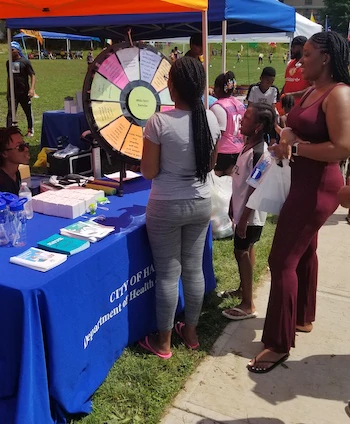Published 2019
Hartford Teen Pregnancy Prevention Initiative
 “It wasn’t a boring lecture about sexual health; it was fun and interactive.”
“It wasn’t a boring lecture about sexual health; it was fun and interactive.”
- HTPPI program participant
Program Description
The Hartford Teen Pregnancy Prevention Initiative (HTPPI) collaborates with community, faith, educational, and medical organizations to provide a citywide network of sexual health education and clinical reproductive health services for youth.
Program Snapshot
- Population: Students in grades 6-12
- Location(s): Hartford, CT
- Partners: Connecticut Women’s Education and Legal Fund, Hartford Public Schools, Planned Parenthood of Southern New England, Saint Joseph’s University, and community-based organizations throughout Hartford
Goals
- Reduce rates of teen pregnancy and sexually transmitted diseases (STDs) in the City of Hartford
- Establish a sustainable, citywide system to provide sex education
- Increase youth access to reproductive health services
- Train youth to serve as sexual health educators and advocates in their communities
Strategies
School- and faith- based interventions
HTPPI offers three sexual education curricula: the Get Real program in middle schools; the Be Proud! Be Responsible! program in high schools; and the Making a Difference program in faith-based organizations. Using videos, games, brainstorming, roleplaying, skill building, and small group discussions, the interventions provide information about pregnancy and STDs and develop students’ communication and decision-making skills. HTPPI has trained faith-based staff to facilitate Making a Difference and is working with health educators to incorporate content from Get Real and Be Proud! Be Responsible! into Hartford Public Schools’ curriculum. After fall 2019, Hartford Public School teachers will take over implementation of the school-based interventions, with HTPPI providing technical assistance where appropriate.
Increasing access to clinical services
After collecting data on barriers to youth access to reproductive health services, HTPPI worked with three health centers to make their offerings more accessible to youth. For example, health centers have added evening hours; set up a teen-only waiting room; and hosted monthly “Teen Nights” where youth can access services free of charge. HTPPI also coordinates capacity-building activities, including trainings for physicians on adolescent health and developmental psychology.
Collaborative approach
HTPPI brings together organizations from the education, faith, nonprofit, and government sectors to collaborate on every aspect of the program, including setting goals, identifying barriers, developing solutions, training staff, and implementing programs. HTPPI also incorporates youth voices through the Youth Leadership Team, whose members spread the word about HTPPI by hosting events for teens, participating in health fairs, and serving as peer sexual health educators in their schools and communities .
Stats at a Glance
- 34.9 Hartford teen birth rate (per 1,000 females ages 15-19) in 2011-2015*1
- 22.3 National teen birth rate (per 1,000 females ages 15-19) in 20152
- 2,779 Middle and high school students served through HTPPI (2015-2018)
* Reflects the most recent available data. Because the number of teen births for some towns is too small to produce reliable estimates for a single year, estimates use 5-year aggregate rates.
Improvements after participating in HTPPI (2016-2018):
- 28% Increase in the number of students who felt comfortable talking to their parents/guardians about sex
- 21% Increase in the number of students who said it is not okay to pressure someone into sex
Grantee Information
Carmen Chaparro
Project Leader
860-757-4743
chapc001@hartford.gov
https://www.hartfordct.gov/
Print the full success story here.
About the TPP Program
The Office of Population Affairs Teen Pregnancy Prevention (TPP) program is a federal grant program that funds diverse organizations working to prevent teen pregnancy across the United States. OPA invests in both the implementation of evidence-based programs and the development and evaluation of new and innovative approaches to prevent teen pregnancy. The OPA TPP program reaches adolescents ages 10-19, with a focus on populations with the greatest need in order to reduce disparities in teen pregnancy and birth rates.
Footnotes
1 Jiang, Y., Mueller, L.M., & Backus, K. (2018). Connecticut Registration Report: Births, Deaths, and Marriages, Calendar Year 2015. Hartford, CT: Connecticut Department of Public Health. https://portal.ct.gov/-/media/Departments-and-Agencies/DPH/Vital-Statistics/Registration-Reports/Reports/RR2015.pdf?la=en. back to top
2 Martin, J.A., Hamilton, B.E., Osterman, M.J., Driscoll, A.K., & Mathews, T.J. (2017). Births: Final data for 2015. National Vital Statistics Report, 66(1). Hyattsville, MD: National Center for Health Statistics. https://www.cdc.gov/nchs/data/nvsr/nvsr66/nvsr66_01.pdf. back to top
 An official website of the United States government
An official website of the United States government
